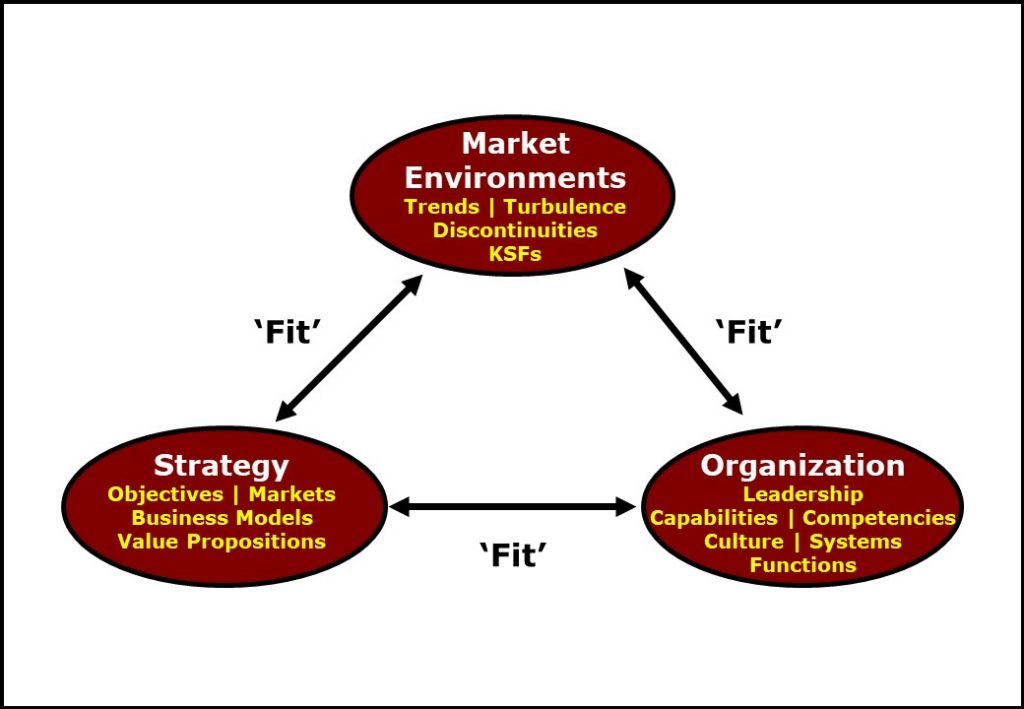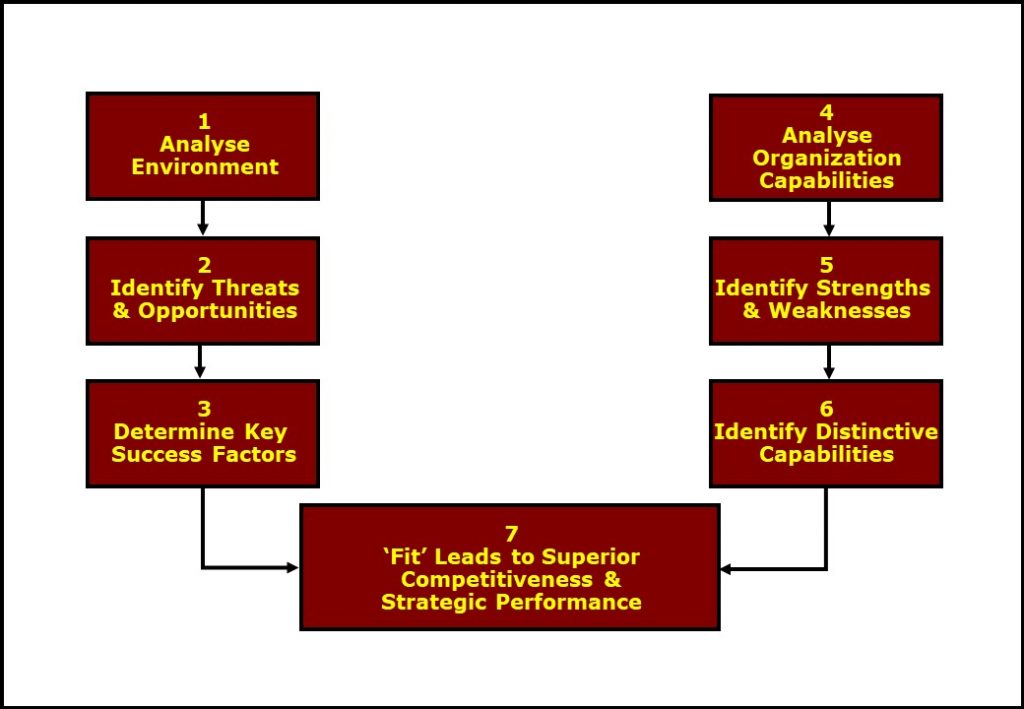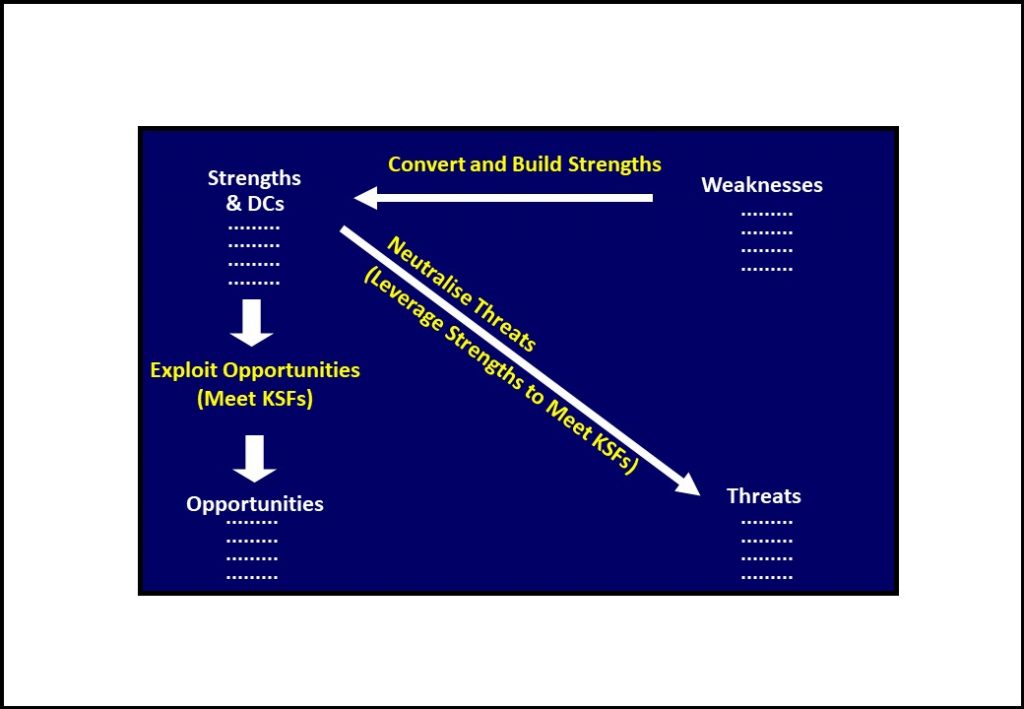Appendix One
Building a Comprehensive Strategic Audit
Introduction
Business school academics and social scientists can be aloof in defence of their theories and are often contemptuous of anything learned by management practitioners in the illustrious ‘university of life’, i.e. ‘on-the-job’. Consider, for example, the following quotation from the philosopher Roland Barthes (1915-1980): “The war against intelligence is always waged in the name of common sense”. We beg to differ, arguing throughout British Business Manifesto: Strategies for Profitable Growth that theory and practice go hand-in-hand: ‘… a way of thinking, a way of working’ represents our fundamental outlook on the foundations of success in SME business strategy.
Aligning Theory & Practice
Aligning theory and practice from this perspective enables us to present in simple graphical form what we describe as The Environment-Strategy-Organisation Nexus. This is illustrated in Figure 1 below, followed by an overview of the process we use to build a comprehensive strategic audit.

The double-headed arrows which link the three key dimensions in the figure above, along with the word ‘Fit’ on the axes between them, demonstrate two fundamentals relating to the theory and practice of business strategy:
-
-
- Each element of the ‘triangle’ impacts the others, i.e. they constitute a nexus of inter-dependence.
- The three elements of the triangle must be in alignment (‘Fit‘), i.e. the strategy should be appropriate for the external market conditions and the organisation should be designed to effectively and efficiently implement the strategy.
-
Despite this, business strategy development is a process that requires a starting point. The more turbulent the market environment the more important it is that an external focus is adopted by companies, the logical conclusion being that the correct analytical sequence in the framework above is:
-
-
- Environment.
- Strategy.
- Organisation.
-
This process should be embedded in a company or business unit’s ‘way of working’, i.e. it is a business environment and organisational auditing approach which should be adopted with the same rigour, discipline and frequency as the financial audits which consume so much managerial energy yet add very little strategic value in most cases.
Key Questions in Business Strategy Development
There are four key question categories to address when crafting a business strategy for sustainable competitive success. These are:
1. Where are we now? – Situational Analysis
# Environment scanning & SWOT/TOWS
# The 5 forces of competition
# Core capabilities & competencies
# Strategic marketing assets
# Portfolio & risk assessment frameworks
# Benchmarking against ‘best-in-class’ companies
2. How did we get here? – Company History
# Culture audit
# Structural audit
# Formal power base audit (e.g. hierarchy, governance etc.)
# Political process audit (e.g. informal power bases, decision making influences, stakeholder analysis etc.)
3. Where do we want to be? – Strategic Direction
# ‘Tomorrow’ (1-3 years)
# Medium term (3-5 years)
# Long term (5 years plus)
4. How do we get there? – Strategy Delivery
# Developing core competencies & capabilities
# Value chain reconfiguration
# Organic development
# Innovation processes
# Joint ventures & strategic alliances
# Mergers & acquisitions
Our primary focus in this Appendix is on Question 1, situational analysis. It is essential that companies have a clear and objective understanding of their competitive position before embarking on business strategy development. The output of the logical TOWS process we describe below presents strategic priorities and action plans (aligns with Chapter One).
The rationale for the analysis relating to Question 2 lies in the fact that a company’s history and ‘cultural baggage’ very often prevent it from ‘doing the right things’ with regard to Questions 3 and 4 (aligns with Chapter Eight).
Question 3 responses must recognise the fundamental reality of scarce resources and that strategic decision making boils down to making choices amongst alternatives, the goal being to increase the likelihood of successful high-performance outcomes. These typically arise where there is alignment between market opportunity and company capabilities (aligns with Chapters Two through Six).
Responses to Question 4 will reflect the logical outcomes of the analyses relating to questions 1-3.
Introducing TOWS Analysis
Most managers and students of business and management will be familiar with the notion of a SWOT chart as a way of taking a snapshot of a company’s ‘strategic position’ at any point in time. They will also recognise it as an acronym, its component letters standing for Strengths, Weaknesses, Opportunities and Threats, the S and W relating to internal, organizational factors, the O and T relating to external business environment factors.
As a management tool SWOT is extremely easy to learn and can be quickly and simply applied. However, in management practice it is often seriously flawed in its application. There are several reasons for this (see Chapter Eight), the most important one being that a company takes an ‘inside-out‘ approach to strategy development, focusing on the capabilities it currently has rather than identifying those required for a fast-changing business environment.
The approach we employ to counter this begins with an external business environment assessment, an analysis we define as a business environment audit. This definition is inspired by a seminar led by the successful entrepreneur Jürgen Priglinger, and his ‘business philosophy’ in this regard is worth quoting here in full:
Business environment audits are more important than financial audits. The latter only count the cents the company has earned already whereas the former is the basis for generating a stream of cash flows for the future. A strategic audit is a comprehensive, systematic, independent and periodic examination of a company’s business environment, objectives, strategies and activities with a view to determining problem areas and opportunities and recommending plans of action to improve a company’s strategic and financial performance.
We address the problem of using traditional SWOT analyses with a simple reversal of SWOT to TOWS, i.e. we adopt an ‘outside-in’ perspective on strategy development. This is not about measuring different things; rather, it relates to creating an external company ‘mindset’.
Figure 2 provides a process-based approach to constructing a logical TOWS analysis that combines the concepts and issues introduced in Chapter One (business environment audit) with those presented in Chapter Eight (organisational implementation audit) and aligns with the four strategy questions previously discussed.

The numbers in the boxes indicate the sequential nature of the process, i.e. it is a critical path of activities that should be undertaken to build a comprehensive strategic audit.
A few points are required here for clarification.
-
- TOWS, not SWOT: As noted, managers with even basic-level training will be familiar with a ‘SWOT’ chart. The reasons for the reversal to TOWS in this process are twofold: (i) to emphasise an ‘outside-in’ analysis, especially important in turbulent business environments; (ii) to link the categories, i.e. strengths and weaknesses should be assessed relative to opportunities and threats, not in isolation of them.
- Market Key Success Factors (KSFs): These are often called Critical Success Factors (CSFs) or ‘Qualifiers’ but this is mere semantics. They are all measuring the same thing. Our preferred simile is ‘market dictators’: the minimum factors which market conditions indicate that any company must have covered if they want to ‘play the game’, i.e. they are not competitive differentiators.
- Company Distinctive Capabilities (DCs): If any company in a market space lists ‘good people’ as a strength while all other companies competing in the same space do the same then there is a problem with the framework: strength is a relative, not an absolute metric. At best the factor can be described as neutral. DCs in our analysis are those factors that give a company a sustainable differential advantage in the time frame of the planning period.
The output of this analysis is the identification of strategic priorities and action plans. Figure 3 presents a simplified overview of these.

In addition to the observations related to this analysis in the book, we also demonstrate a creative process for strategy development. Insights here include leadership, teamwork and the role of independent facilitators in ensuring objective analysis.
Learning Outcomes
After studying this appendix readers will:
-
- Understand the role of situational analysis as the foundation for successful strategy development.
- Have the competencies to contribute to the strategic auditing process.
- Have the capability to lead and/or facilitate the strategic auditing process.
- Understand the key components of creative thinking, teamwork and ideas generation in strategy development.
- Apply the principles of strategic analysis and action planning using proven frameworks, methodologies, processes and tools.
Concluding Remarks
In this appendix synopsis, we have reinforced a claim that has been repeated throughout the book: if a strategy cannot be implemented, it’s not a strategy at all. We have combined an overview of key management principles with a description of a proven method of crafting business strategy.
In sum: A way of thinking, a way of working.
Please click/tap the SME Business Strategy Events tab of the Main Menu to view the range of multiple format business strategy events (courses, seminars, masterclasses, workshops, think-tanks, webinars etc.) designed in conjunction with the chapter contents of the book. The opening sections of the page present the same content as that discussed in this Appendix One synopsis.
Please click/tap your browser ‘Back’ button to return to the location navigated from. Alternatively, click/tap the ‘Bookshelf & Typewriter’ graphic below to navigate to the British Business Manifesto: The Book page.
All content © Colin Edward Egan, 2023

